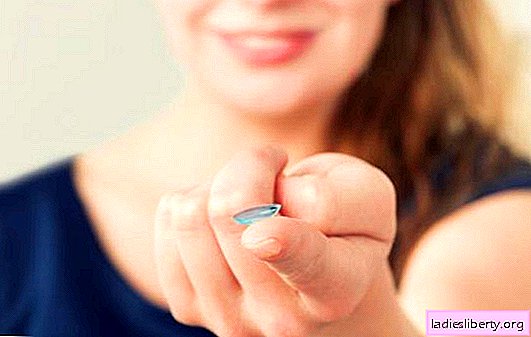
Women need to learn to recognize physiological and pathological secretions. For example, the first type of discharge includes menstruation, during which a woman should lose about 80 ml of blood. If menstruation is abundant, clots come out with blood, or discharge after menstruation appears, this may indicate the development of pathological processes. Let's figure out for what reason there may be a discharge after menstruation.
Discharge after menstruation
So, the discharge after menstruation is often evidence of a hyperplastic process in the endometrium, a myoma, which deforms the uterus, etc. Such processes can provoke difficulties in conceiving a child. They also often cause infertility.
Noticing the appearance of discharge a week after menstruation, be sure to tell about it to your gynecologist, who will establish the nature of the pathological processes and prescribe the appropriate treatment. For example, if you go to a doctor with brown secretions after menstruation, then his task is to exclude or confirm the possibility of developing internal endometriosis, whose treatment is prescribed based on the severity of the anomalous process, determining the extent of endometrial growth. If endometriosis is not eliminated, the woman risks becoming infertile. In addition, she will have to deal with pain during intercourse, bowel movements and urination.
The discharge after menstruation can be inflammatory. They are usually accompanied by a burning sensation and itching in the region of the external genital organs. Such secretions appear in gonorrhea, chlamydia, thrush, trichomoniasis, bacterial vaginosis. When the pH of the vagina changes and bacterial vaginosis develops, creamy white discharge smelling of fish appears, which may have a grayish tint. In the case of discharge after menstruation, indicating bacterial vaginosis, go to a doctor who can cure your illness within a week.
White cheesy discharge, itching, swelling of the external genital organs indicate candidal vulvovaginitis (thrush). This disease is treated with medication for a rather short period. Recurrent vulvovaginal candidiasis after adequate treatment occurs in no more than five percent of women.
For your information: both of these diseases usually occur due to a violation of the vaginal flora and appear after an uncontrolled intake of antibiotics, due to a violation of hygiene, reduced immunity, the wearing of synthetic, not breathing and too tight linen.
Warning: a woman with recurrent thrush should be monitored not only by a gynecologist, but also by an endocrinologist. After all, such states can talk about the development of diabetes.
White, foaming and watery discharge - the main sign of the development of trichomoniasis. Such a venereal disease is difficult to diagnose. The diagnosis is often made precisely by the nature of the discharge. When trichomoniasis is detected, an examination for gonorrhea and chlamydia should be performed.
But still, a woman should have normal discharge after menstruation. They may vary depending on the phase of the cycle. In healthy women with regular menstrual discharge after menstruation, there are two types. In the first phase of the cycle, the highlights are white as well as transparent, in the second they are less transparent and more white. Before menstruation, physiological discharge sometimes acquire some lumpiness and sour smell. In most cases, the discharge after menstruation does not smell, and their color should not be anything other than white.
Brown discharge after menstruation
Brown discharge can appear not only after menstruation, but also during menstruation. If you notice a brown discharge during menstruation, no need to worry. The substance released is normal menstrual blood, which, interacting with oxygen, oxidizes and takes on a brown color. Such discharge is typical for women with scanty menstruation. But if a woman has a small amount of brown discharge after menstruation, as well as before the onset of heavy menstruation, this may indicate a deficiency of the second phase of the cycle caused by low progesterone. To confirm that brown secretions appear for this reason, you must donate blood for progesterone on days 21-23.
Low progesterone is not able to prepare a woman for normal menstruation. After all, if progesterone is low, it means that a thin endometrium is formed in a woman, which is underdeveloped. This endometrium is rejected by a thin layer. At the same time, he may either depart or not. In this case, the girl thinks that her menstruation has already ended, and then she wonders why there were brown discharges after menstruation. And in fact, these brown secretions after menstruation are the usual menstrual blood, which is secreted by the body of a woman with a low level of progesterone.
If you have a failure of the second phase of the cycle, and you plan to become pregnant, then you need to run to the doctor, seeing the brown discharge after menstruation. Why do you need it? Progesterone is not only preparing the endometrium to the beginning of menstruation. He also prepares the endometrium for taking a fertilized gamete (ovum). But a poorly developed endometrium due to low progesterone is not the best basis for a fertilized egg.
Brown secretions that appear from the genital tract after menstruation, can talk about endometriosis. To confirm this pathological phenomenon, the patient must undergo hysteroscopy. Such an examination of the uterus and canal of the cervix using the optical system will help to assess the severity of the pathology of the uterus, the mouth of the tubes and endometrium. This examination method is minimally invasive. In the course of the examination, it is possible to conduct surgery aimed at eliminating endometrial polyps and endometrial hyperplastic foci. Usually, hysteroscopy is performed on the 5-13th day of the menstrual cycle.
And brown discharge after menstruation may also occur due to the development of trophoblastic disease. It often manifests itself in the form of syncytial endometritis or blistering. Trophoblastic disease is treated surgically.
After menstruation go
We have already mentioned that if you have discharge after menstruation, this may indicate endometriosis, myoma, low progesterone, inflammatory diseases, etc. But what does it mean if after some time after menstruation there is spotting and a woman I learned that she was pregnant. First of all, she needs to see a doctor, having described in detail the signs of bleeding (duration, profusion, color of discharge), without forgetting to mention other associated manifestations.
If after menstruation there are discharges, and the woman is already carrying a child, then this may be quite normal. Pregnancy after menstruation occurs in girls with early ovulation, or in those women who have been fertilized by survivable and expectant spermatozoa, who got inside during sex during menstruation. But the common nesting of a fertilized egg becomes a frequent cause of short-term and low-abundant bleeding in the first trimester of pregnancy. But in any case, be sure to go to the doctor to play it safe and make sure that there is nothing dangerous when you have discharge after the menstruation, which the unplanned pregnancy could not even stop.
Spotting after menstruation
Every woman is obliged to be wary of finding bleeding after menstruation, which may so inappropriately appear in the middle of the cycle, when blood should not be released. This may indicate that benign or malignant neoplasms have arisen in the uterus. Often women have fibromyoma, which leads to prolonged bleeding during menstruation and often causes bloody discharge after menstruation. Discharges appear when tumor cells begin to bleed. Women with bleeding after menstruation are frequent guests should go to the doctor without excuse.
Abundant bleeding after menstruation or a small release of blood from the vagina in the same period may indicate ectopic pregnancy. In such a situation, apart from the discharge, severe pain often worries, which can spread to the entire peritoneum and intensify during movement, coughing, etc. Also symptoms of ectopic pregnancy are: vomiting, weakness, dizziness, feeling of pressure on the sacrum, pain in the shoulders.
To avoid rupture of the oviduct, and as a result of it - severe bleeding, it is necessary to determine the nesting of the fruit egg in time. In the case of a wrong position of a fertilized egg, measures should be taken to get rid of ectopic pregnancy. There are two ways to recognize an ectopic pregnancy: by monitoring the level of the hormone hGG, whose growth will decrease if not properly nesting; by examining the uterus and oviduct with ultrasound equipment.
Attention: in ectopic pregnancy, instead of heavy bleeding from the vagina, brownish discharge may come out.
Girls who became pregnant due to early ovulation, having sex during menstruation, and who for some reason, in addition to all, had bleeding, after menstruation are prone to panic. But who knows that such secretions sometimes appear during implantation of a fertilized egg and are considered relatively normal, they put to sleep their fear, which is not always good. Why? Spotting after menstruation in early pregnancy may indicate a miscarriage or appear due to improper nesting of the fruit egg (already mentioned more than once today). When the last case occurs, the patient needs surgical treatment. If you do not perform a laparoscopic operation, during which the fertilized egg is removed or the entire fallopian tube, the likelihood of death increases.
Important: In order to stop the development of the ovum and its resorption upon the occurrence of an ectopic pregnancy, some specialists have used special medications with a thermogenic and embryotoxic effect.
It happens that the cause of the appearance of bleeding after menstruation for women who become pregnant during menstruation does not work out and the whole story ends with a successful delivery. But it is better not to engage in self-diagnosis and go to the gynecologist immediately, when you have bleeding after menstruation. This is especially true of those women who unexpectedly conceived a new life and already know about it.
Pink discharge after menstruation
Most women are confident that pink discharge after menstruation is a rather rare phenomenon. Ladies are accustomed to think that pink exits indicate late miscarriage. Since spontaneous removal of the fetus, which is referred to as late miscarriage, does not occur before the end of the first trimester, the expression “discharge after menstruation” becomes irrelevant. Usually false monthly can go the first few weeks after fertilization.
But, as proved by those women who have observed pink discharge after menstruation, it is not a matter of miscarriage. Discharges appear with little blood flow. She, mixing with natural white and transparent secretions, paints them in pink. Such a small bleeding may occur due to rough sexual intercourse, inaccurate medical examination, as a result of which microcracks appeared.
Also, pink discharge after menstruation may indicate that a woman needs to change her unsuitable intrauterine device or stop taking oral contraceptives. But since the discharge of a pink color sometimes indicates the development of infectious processes, serious diseases of a different nature, endocrine disorders, it is certainly worth talking to a doctor about them and undergoing a gynecological examination. Pink discharge after menstruation often appear before early ovulation.











